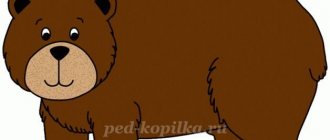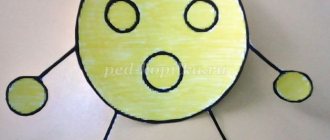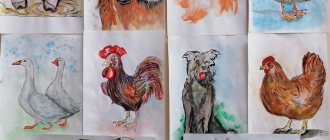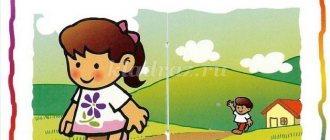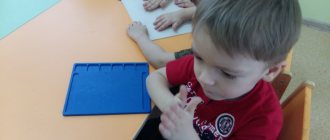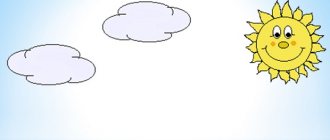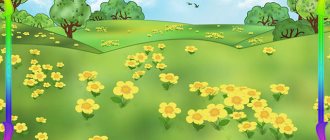Summary of an open lesson in mathematics “Big and Small” in the second junior group.
Summary of an open lesson in the 2nd junior group.
Compiled by: Educator Gorkovenko N.A.
MB preschool educational institution “Kolokolchik” No. 1 village. Kuibyshevo
Topic: “Big and small”
Goal: 1) consolidate the ability to distinguish and name the sizes of objects - large, smaller, small;
2) consolidate the ability to distinguish and name colors, compare objects by color and size;
3) train mental operations of comparison and analogy, develop memory, speech, imagination.
Materials for the lesson:
Demonstration: toys of three bears, a magic chest, a mother bear mask.
Handout: three squares of different sizes and different colors for each child, bear masks for each child, three cubes of different sizes and different colors.
Progress of the lesson:
— Guys, do you like fairy tales?
— Do you know the fairy tale “The Three Bears”?
— Do you want to go visit the bears?
— To get into a fairy tale, magic must happen. Look, I have a magic chest, and now a miracle will happen. (The teacher puts on bear cub masks for the children and a bear mask for himself.)
“You are little bear cubs, and I am your mother, a bear.”
Physical school
Three bears were walking home. (Children waddle in place.)
Dad was big - big. (Raise your arms above your head, pull up.)
Mom is shorter with him, (Hands at chest level.)
And my son is just a little baby, (Sit down)
He was very small, (Squatting, swaying like a bear.)
He walked around with rattles. (Stand up, hands clenched into fists in front of your chest.)
Ding - ding, ding - ding. (Children imitate playing with rattles.)
Children approach the table, on which the toys of three bears are arranged out of order.
- Guys, show me Papa Bear.
- Why do you think that dad is this particular bear? (Because it's the biggest.)
- What kind of mother is a bear? (She's smaller.)
- Which Mishutka? (He is the smallest.)
- Show with your hands the biggest bear (smaller bear, smallest bear).
The teacher places the bears in order, calling their size: large, smaller, smallest.
- Guys, now I suggest you give gifts to the bears.
Children approach tables on which there are three squares of different sizes and colors.
— Show me the rug that you will give to daddy bear.
- What colour is he? (Red)
— Why are you giving a red rug to Papa Bear? (Because it's the biggest.)
— Show me the rug that you will give to your mother bear.
- What colour is he? (Green)
- Why are you giving your mother a green rug? (Because it's smaller.)
— Show me the rug that you will give to Mishutka?
- What colour is he? (Yellow)
- Why are you giving Mishutka a yellow rug? (Because he is the smallest.)
The teacher suggests folding the rugs so that it is convenient to give them to the bears.
- Take the biggest rug. Place a smaller rug on it. Place the smallest rug on top.
- Now guys, take the rugs in your hands, go up to the bears and give each bear their own rug.
- Guys, do you want to know what else I have in my magic chest?
(The chest contains three cubes of different colors and different sizes.)
The teacher calls three children. Each child takes one cube from the chest.
- Guys, what is this? (Cubes)
-Look, do you see the same or different cubes? (Different)
- How are the cubes different? (Different in color and size.)
The teacher invites the children to choose a cube for each bear.
Asks each child what color the cube is for which bear? Why? Asks children individually. Children place cubes next to each bear.
Lesson summary:
Didactic tasks: to restore in children’s memory what they did in class and create a situation of success. The teacher gathers the children around him:
— Who did you give gifts for today and help pick up cubes?
(For three bears.)
The teacher praises the children and says that they were able to choose rugs and cubes for the bears because they know how to compare objects by size.
Literature:
L.S. Metlina “Mathematics in kindergarten”
E.S. Demina “Development of elementary mathematical concepts”
V.P. Novikova “Mathematics in kindergarten”
Lesson summary on the topic “Big or small”
Bobchenko O.V.
English lesson notes
Topic:
Big or small
Lesson type:
combined
Age:
3-4 years
Target:
practice pronunciation of sounds that cause difficulties for students; repeat and systematize vocabulary on the topic “Animals”; introduce children to the concepts of big and small; introduce new words big, small; introduce children to the new song “Old MacDonald”
Tasks:
- Educational
. Consolidating vocabulary in students’ memory and activating them in oral speech, improving phonetic skills.
- Educational
. Development of speech and cooperation skills. Forming interest in English classes.
- Developmental
. Development of fine motor skills, memory, thinking, concentration. Learning to distinguish objects by size: large - small. Formation of the ability to select and group objects by size. Formation of general communication skills.
Forms of work:
Frontal, individual, group
Teaching methods:
author's technique Shishkova I.A., Verbovskaya M.E.
Equipment.
Toys - animals of different sizes, large and small, balls of different sizes, large and small, vocabulary material, audio recordings, pictures and pencils.
Progress of the lesson
I. Greetings.
-Hello! I am glad to see you.
-Today we will play interesting games and learn a new song.
-Let's stand in a circle and say hello to the Teddy bear.
Children stand in a circle.
The teacher gives each child a teddy bear with the words - Hello, Masha.
The student gives the teddy bear to the teacher and says in response - Hello, Teddy bear!
- How are you?
- Fine, thank you.
II. Phonetic exercise.
Game "Echo"
Goal: establishing correct pronunciation and practicing sounds.
First, the teacher pronounces the sounds in a whisper, and the children must correctly pronounce the pronounced sound. Then the students take turns saying the sounds in a whisper, and the teacher repeats after the students.
III. The main part of the lesson.
- Find and name who hid from the fox.
Goal: repetition of vocabulary on the topic: “Animals”;
The teacher distributes the same picture to the children. They complete the task: Find and say! (Find and name who hid from the fox. Appendix 1)
- Introducing the words big and small
Teacher: Today Teddy Bear did not come to Us empty-handed, look. What is this? Look! What are these?
Children: Balls
Teacher: Well done! Look how different they are. (The teacher shows two different balls, a large one and a small one. He takes the small one and hides it in his hand and explains that it is a small ball. - It's a small ball. It can be hidden in your palms, like this. Masha, do you see the ball?
Child: - No.
Teacher: The ball was hidden correctly, it is small. It's a small ball.
The teacher takes a big ball and says:
- It's a big ball. It's a big ball. It cannot be hidden in the palms of your hands. Roma, is this ball hidden in your palms?
Child: No.
Teacher: Well done! You can't hide it, it's big. It's a big ball.
Then the teacher shows pictures or toys of different sizes and asks the children to name them by size.
- Physical education lesson (taken in the form of the game “Magic Wand”)
Game "Magic Wand"
Goal: consolidation of vocabulary with activation of motor memory.
With the words Hickory, Wickory, Dock, children turn into animals and imitate them
(a dog, a bear - they walk on the outside of the foot, a hare - they jump, a cat, a fish, a frog, a bat etc.). The children then become wizards and turn the others into animals.
- Game "Big or Small"
Goal: consolidation of acquired knowledge in a visual way.
The teacher places 2 boxes on the carpet: large and small, and animal toys of different sizes.
Teacher: The boxes are different in size: this is large, and this is small. Look! There are two boxes, big and small.
First, collect the small toys and put them in a small box. Then the big toys and put them in a big box. (If it is difficult to complete the task, the teacher helps the children).
Teacher: Show me and name the small toys. Show me small toys! And say: — It’s a small monkey!…
Children take turns taking out toys from a small box and naming small animals following the example of the teacher.
Then the same is done with large toys from a large box.
- Performance and display of the song “Old MacDonald” (https://kidsenglish.ru/songs/old-macdonald) – Appendix 2
Goal: formation of audiovisual perception.
IV. Student reflection
— Did you like the song?
— Do you have any pet at home?
— The dog says Woof-woof in English, but what does your dog say?
—Who will lead the Magic Wand next time?
V. Conclusion
Teacher: Guys, our lesson is over, and now let’s all say goodbye to Teddy Bear together.
- Bye kids!
Children:
- Goodbye, Teeddy bear!
Annex 1
Appendix 2
♫ Old MACDONALD had a farm EIEIO And on his farm he had a cow EIEIO With a moo moo here And a moo moo there Here a moo, there a moo Everywhere a moo moo Old MacDonald had a farm EIEIO
Old MACDONALD had a farm EIEIO And on his farm he had a pig EIEIO With a oink oink here And a oink oink there Here a oink, there a oink Everywhere a oink oink Old MacDonald had a farm EIEIO
Old MACDONALD had a farm EIEIO And on his farm he had a duck EIEIO With a quack quack here And a quack quack there Here a quack, there a quack Everywhere a quack quack Old MacDonald had a farm EIEIO ♫
